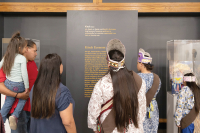Division runs deep over Biden’s domestic agenda
Since his election last November, President Joe Biden has spent a lot of time — and untold political capital — pursuing a sweeping domestic agenda.
Biden declares major disaster in Haywood County
More than three weeks after deadly flash flooding along the East Fork of the Pigeon River killed six and displaced hundreds, President Joe Biden announced that a major disaster exists and that federal assistance will supplement state and local efforts in the affected area.
Haywood scores touchdown on stadium capacity limits
It’s not something that happens all that often, but a late fourth-quarter drive by Western North Carolina’s state and local elected officials helped them find pay dirt in the end zone — in this case, raising the coronavirus-related capacity limits on outdoor high school athletic events.
Heath Shuler steps off the political sidelines
Even Hollywood screenwriters would be hard-pressed to craft a more quintessentially American story.
Heath Shuler previews tonight’s Dem convention
While the big news out of the Democratic National Convention thus far may be the formal nomination of Joe Biden last night, former NC11 Democratic Congressman Heath Shuler — who held the seat before Rep. Mark Meadows — wants Western North Carolina to know that there’s big news coming tonight as well.
Hope is on the horizon for partial Road to Nowhere settlement
 A $4 million payment to Swain County for the so-called Road to Nowhere cash settlement may soon be freed of the bureaucratic purgatory where it’s been parked for more than two years.
A $4 million payment to Swain County for the so-called Road to Nowhere cash settlement may soon be freed of the bureaucratic purgatory where it’s been parked for more than two years.
Rogers takes early lead in congressional fundraising
By Shannan Mashburn • Intern
Democrat Hayden Rogers has commanded the lead in the money race for the congressional election to take over U.S. Congressman Heath Shuler’s seat in Washington next year.
Neither Rogers nor his Republican opponent Mark Meadows raised a staggering amount of money during the spring and summer, when most candidates typically see a drop off in political contributions before the big push going into fall.
Swain uses money from first North Shore Road payment on special projects
While Swain County fights to secure the rest of the $52 million cash settlement its owed by the federal government for the North Shore Road, the $12.8 million already in the bank is generating hundreds of thousands in interest every year.
Since the initial payment of $12.8 million to Swain County in 2010, it has made nearly $1.5 million in interest.
The cash settlement money is held in a trust fund managed by the N.C. Treasury Department. Every year, the state remits a portion of the accumulated interest to the county. The principle itself is safeguarded, and can only be tapped if two-thirds of Swain’s registered voters agree to do so in a special vote, per the terms of the trust fund.
So far, Swain has gotten $150,000 of the interest generated on the account. Even though the actual interest earned on the fund is much higher, some has been reserved as a cushion, intended to safeguard the principle $12.8 million.
Should interest rates take a dive, or even post a lost, the cushion that has been held back should prevent an erosion of that principle sum from dipping below the $12.8 million.
The fund currently stands at just over $14 million, according to the state treasurer’s office. Now that a sizeable cushion has been built up, Swain can expect to see more interest flowing to it each year and less held back. This year, the county could expect as much as $500,000.
How to spend the money is ultimately up to the county commissioners. The current board of commissioners don’t want to merely dump the money into the county’s general budget, but instead want to see it go toward special projects, so the public can see the good the money is doing, according to County Manager Kevin King.
“They didn’t want to see any of the money going to the operational budget because it gets lost in the shuffle,” King said. “We want to be able to identify every penny that goes to every project.”
Likewise, the commissioners are hesitant to use the money for a big-ticket item, like a new school. Dedicating the money to that kind of recurring expense — such as annual debt payments on the same large construction project year in and year out — would tie up the cash settlement interest on a single project for the foreseeable future, King said. Instead, the county is interested in special projects that otherwise would be taxing, if not impossible, for the county to undertake.
So far, the county has spent its cash settlement interest money on public restrooms at a downtown riverside park in Bryson City, a series of historical monuments, a new trash truck and renovation of the historical county courthouse for a museum.
The commissioners have dedicated $50,000 so far for a cultural heritage museum being constructed inside the iconic Swain County courthouse, and have pledged another $100,000 from future interest payments.
Shortchanged again? Swain’s cash settlement flounders in Washington budget bureaucracy
The National Park Service is refusing to let go of a $4 million payment Swain County is due as part of the cash settlement over the North Shore Road.
The federal government is supposed to pay Swain County $4 million a year over the next decade — a deal intended to finally compensate the county for a road that was flooded when Fontana Lake was built in the 1940s.
Swain has had little luck getting the government to make good on the pledge, however.
Swain didn’t get the money in 2011 after Congress clamped down on earmarks. This year, the money was supposedly included in the National Park Service’s construction budget by both the President and Congress, but the park service isn’t releasing the money.
“It is currently sitting in the National Park Service’s account,” said Whitney Mitchell, spokesperson for Congressman Heath Shuler, D-Waynesville. “It is unclear why the National Park Service has delayed transferring the $4 million payment out of their budget into the Swain County trust fund.”
The National Park Service claims it doesn’t have proper authorization to make the payment.
Simply including the money in its budget isn’t enough. The park service claims it needs specific authorization — spelling out that $4 million should be handed over to Swain County — included as part of the budget bill that was passed by Congress last December.
SEE ALSO: Swain uses money from first North Shore Road payment on special projects
“While the funding was included in the final bill, the necessary language was specifically excluded,” said Jeffrey Olson, a spokesperson for the National Park Service in Washington, D.C.
Without that language, it won’t turn over the money, Olson said.
“Everybody agrees the $4 million for Swain County was passed,” said Leonard Winchester, a Swain County resident who has been working on behalf of the cash settlement for years. “Why this money can’t be turned loose because someone at Department of Interior said they didn’t have the proper authorization, I don’t know.”
Shuler’s office, meanwhile, claims the money included in the budget carries clear instructions to be handed over to Swain County.
Olson was unable to address the apparent stalemate, simply reiterating that the park service lacked authorization to release the money.
“That is the end of the question for us,” Olson said. “If a member of Congress says ‘Yes it is,’ and we say, ‘We don’t have it,’ that’s as far as I can take it. It either shows up in the language of the appropriation bill or it is not there.”
Specifically, the money for the cash settlement was included as part of the National Park Service’s construction budget, a total of some $159 million. That’s something even Olson agrees with.
But where he differs is whether the $4 million for the cash settlement needs its own authorization before it can be released.
Olson said everything else in the construction budget carried the necessary authorization. That authorization usually comes in the form of an itemized list of approved construction projects.
“When we have a construction budget, it often includes a list of projects. It is my understanding that list of projects is our authorization,” Olson said.
However, that itemized list doesn’t show up in the appropriation bill passed by Congress in December. The list was left out of the final bill.
“Where it went astray was they didn’t keep the list. It just devolved to a single number,” Winchester said. “Whatever wording the National Park Service thought ought to be there went away, and they ended up with a lump sum number for their construction budget.”
That begs the question: Can the National Park Service not spend any of the $159 million in its construction budget this fiscal year because it too lacks authorization due to the absence of the list? Or is Swain’s cash settlement is being held to a double standard?
Olson said the National Park Service doesn’t need specific authorization for the rest of its construction budget. When it comes to the rest of the $154 million construction budget, the passage of the appropriations bill itself counts as authorization even though the list was left out of the final budget bill, Olson said.
“There is no requirement that this list of construction projects be attached to the appropriations bill Congress passes and the President signs before we proceed with the projects,” Olson said.
But as for the $4 million cash settlement contained in that same construction budget? The park service wants Congress to pass specific language saying its OK to pay it out.
Apparently, even though the money was included in the park service construction budget, the park service isn’t willing to consider the cash settlement as “construction.”
Leonard points out that the cash settlement is a substitute for constructing the road itself, and so in a way, it is kind of construction — since it is “in lieu of” construction.
At one point, there was indeed an itemized park service construction list circulated in budget talks. The cash settlement was allegedly on the list. The list was even referenced in budget committee documents as the “go-to” list for what the National Park Service should spend its construction budget on.
“The amount provided will fully fund the NPS construction projects as prioritized by the Service pursuant to the Administration’s revised request list provided to the Committees on June 24, 2011,” according to a draft version of the National Park Service appropriation bill.
Olson didn’t want to talk about what type of authorization the National Park Service needs at this point to fix the situation.
“Those are conversations that happen between a congressman and the National Park Service,” Olson said. “We are not going to use your newspaper as a way to communicate with Swain County.”
However, that’s exactly the question that has stymied everyone working to secure the cash settlement.
“Somebody, somewhere, has to know if there is something missing, what it is,” Winchester said.
Winchester has followed the labyrinthian appropriations process through Congress. He even flew to D.C. in 2010 along with a delegation from Swain County to meet with Ken Salazar, the Secretary of the Department of the Interior, to remind him of the cash settlement promise.
Winchester said it is disappointing to fight so hard, to see the money included in the budget, but to come up empty-handed.
Insult to injury?
The cash settlement was intended to resolve a festering decades-old dispute between Swain County and the federal government over a road flooded during the construction of Fontana Lake back in the 1940s. At the time, the government promised to rebuild the road one day, but never did.
Nearly seven decades later, the government instead promised to make good on its broken promise by paying Swain the cash value of the road that was destroyed — a value pegged at $52 million.
The money was supposed to be appropriated by Congress to the tune of $4 million a year until the obligation was settled. But after an initial down payment of $12.8 million in 2010, Swain hasn’t seen a penny since.
The cash settlement was supposed to make right on the long-standing obligation to Swain County citizens. The federal government signed a memorandum of understanding amid great pomp and circumstance in 2010, a ceremony attended by some 200 people at Swain County High School, pledging to reimburse Swain County for the road.
If it’s authorization the park service wants in order to release the $4 million included in this year’s budget, how about that memorandum of understanding, signed by the Secretary of the Department of Interior Ken Salazar, promising to pay it? Winchester said that ought to be good enough.
“Each individual subsequent appropriation does not require a new additional authorization,” Winchester said. “These joint acts by the federal government and by Congress constitute the authorization, recognition, expectation and plan for future payments, if and when they are appropriated.”
Congressman Shuler has been a champion of the cash settlement. He grew up in Swain County and rode his football stardom there and at nearby Tennessee to his congressional seat in Washington.
Shuler had to lobby for the appropriation on two fronts. He worked closely with the Obama Administration to get the $4 million payment included in the National Park Service budget this year, Mitchell said.
He also had to shepherd the line item through Congress to make sure it remained intact during the budget process.
“Rep. Shuler worked closely with House leadership to ensure the $4 million annual payment the President promised and requested as part of the North Shore Road settlement was fully funded in the 2012 Appropriations bill,” Mitchell said.
Shuler is remaining optimistic.
“Rep. Shuler fully expects the National Park Service to fulfill the President’s request and uphold the federal government’s legally-binding obligation to Swain County by making the payment before the end of this year,” Mitchell said.
Mitchell pointed out that the government signed a “legally-binding” memorandum with Swain County.
Even with an ally in Shuler fighting for the cause, the cash settlement seems to have stalled out almost as soon as it was promised. Shuler is now serving his last year in office, however, having announced this winter he would not seek re-election.
Whether Shuler’s successor will fight with the same vigor for the settlement leaves the future of the payments in even greater limbo.
Shuler’s office says he will impress on whoever comes along after him to carry the torch.
“Our office will fully brief the incoming 11th District representative to ensure they have the information and resources they need to follow in Rep. Shuler’s footsteps and continue his leadership and hard-fought efforts on this front,” Mitchell said.
For now, Swain County leaders haven’t gotten actively involved in hunting down the $4 million that allegedly has their name on it somewhere in the National Park Service budget. Instead, they were counting on Shuler to fight that battle for them.
“The money is in the account ready to go but nobody is willing to sign the check,” Swain County Manager Kevin King said, proffering his version of the cash settlement’s status.
But Swain County commissioners might need to start rattling some cages.
“We might have to at some point in the future,” King said.
What is the North Shore Road?
The so-called “Road to Nowhere” is a source of bitter resentment for the people of Swain County. Before it was flooded, the road traveled for more than 30 miles from Bryson City to Tennessee. The route was dotted with homes, farms, schools, churches, cemeteries and general stores of numerous Appalachian settlements going back generations.
When Fontana dam was built in the 1940s, what wasn’t consumed by the rising water of Fontana Lake was folded into the Great Smoky Mountains National Park. Hundreds of people were forced to leave their homes forever.
The federal government promised in writing at the time to rebuild the road, but after pecking away at a dozen or so miles in the 1950s and 1960s, it was abandon due to the exorbitant costs and environmental hurdles of building the remaining 20 or so miles.
It became a symbol of Washington’s failure to keep promises to rural Appalachia. Swain County, after all, had paid to build the road in the first place — and had to keep paying off the construction debt for years after the road didn’t exist anymore.
A deep-seated distrust and disillusionment set in over the intervening decades.
Primary for state House seat attracts new Republican field
When it comes to the election season, 2012 has turned into a bellwether year for North Carolina, and Republicans are clammoring to claim state and federal seats currently held by Democrats.
Even the popular N.C. House Democrat Ray Rapp, who has enjoyed two uncontested election seasons, is now facing mounting competition for his 118th District seat. Rapp has represented Haywood and Madison counties in the N.C. House for 10 years.
“I think this is a really interesting year,” said Chris Cooper, a political science professor at Western Carolina University. “There is so much uncertainty.”
Rapp will be pitted against one of three Republican candidates come fall.
The make-up of Rapp’s district changed only slightly when new lines were drawn following the national census, a political shuffle that occurs every 10 years to ensure that each district still has roughly the same number of residents.
Rapp’s district has lost parts of Haywood County and picked up the whole of Yancey County.
Prior to the reconfiguration, the district was 28 percent Republican, but it is now 31 percent.
The three Republican candidates hoping to take on Rapp are:
• Jesse Sigmon, 63, is retired from the Department of Revenue but works part-time at Builders Express in Mars Hill, where he currently resides. Sigmon ran unsuccessfully for state office in 1998 and again in 2000, but he said the new district make-up could be the change he needs to win.
“The numbers are more favorable to a fair election for a Republican,” Sigmon said. “I did not feel I could win in the past few elections because of the numbers.”
• Michele Presnell, 60, is a current Yancey County Commissioner and owner of Serendipity Custom Frames in Burnsville. She is also the wife of former state senator Keith Presnell. Presnell said that the district needs a change — someone who can better represent its constituents.
“This is a new district, and I feel that I can represent the people of this district in a more conservative way,” she said.
• Ben Keilman, a Canton resident and Pisgah graduate, is by far the youngest competitor at 23. He recently graduated with a political science degree from the University of North Carolina in Chapel Hill, where he was active in College Republicans. Keilman currently works for his father at Asheville Cabinets.
In the last election two years ago, Republicans took control of the state legislature for the first time in a century. And, the political tide in North Carolina continues to turn in favor of the traditionally more conservative party, Cooper said.
“More Republicans think they’ve got a shot,” he said, later adding that the once-light blue state now has a purple tint. “This is all just a path to becoming a red state.”
However, disorganization among the state Republican Party, witnessed by the outpouring of so many candidates in the primary, will benefit Democrats in the long run, Cooper said.
“The Republican’s don’t seem to have an organized party to sift through these candidates,” Cooper said. “The lack of party organization is really striking to me.”
The race for Heath Shuler’s seat in Congress is another election in which Republicans will need to narrow the field. It is even more hotly contested with eight Republicans battling for their party’s nomination.
Although the House district held by Rapp is still majority Democrat, it does not mean that the race will be a cakewalk for Rapp, however.
“I think it will be a little more difficult,” Cooper said.
Rapp agreed that the district is more competitive than it once was and said he will focus on visiting all corners of the district and meeting with constituents — something he has become known for.
“It’s too easy to get drawn into the world in Raleigh and forget your roots,” Rapp said. “Accessibility, I hope, has been a hallmark of my terms.”
Rapp said he is occasionally teased that he will show up anywhere-even a goat roping.





